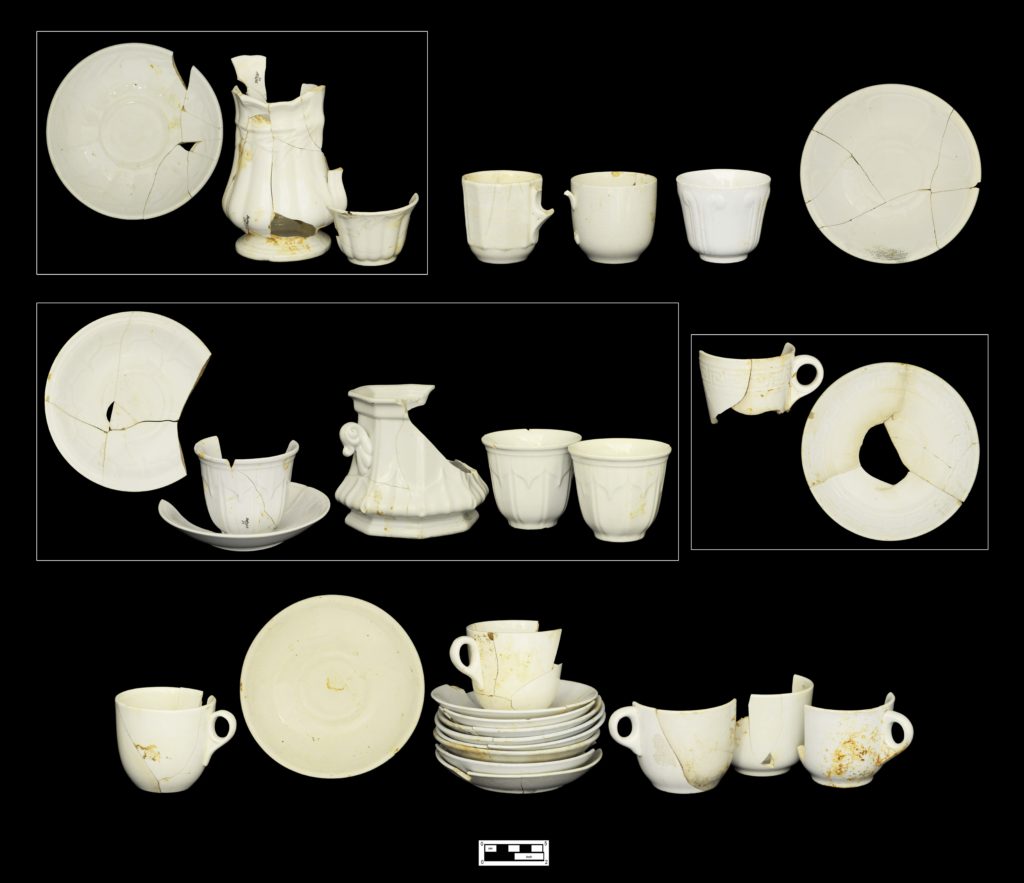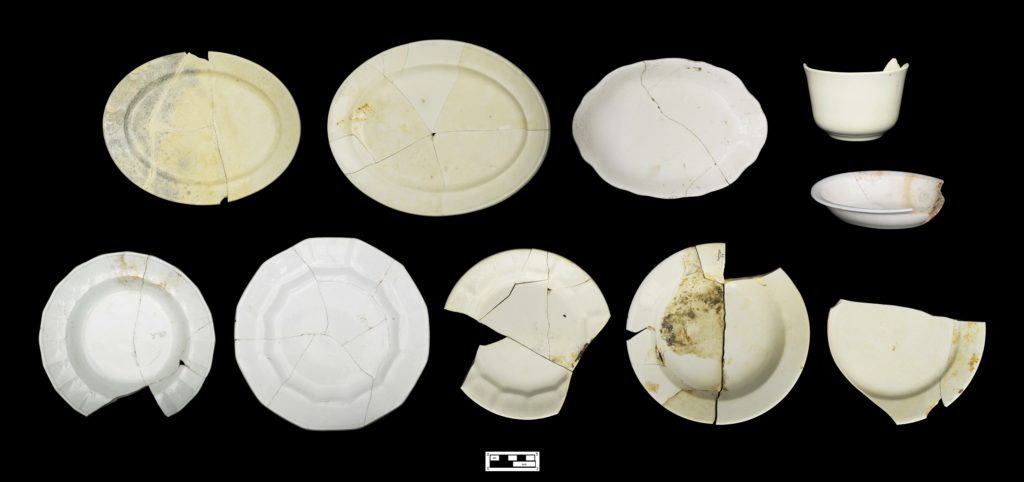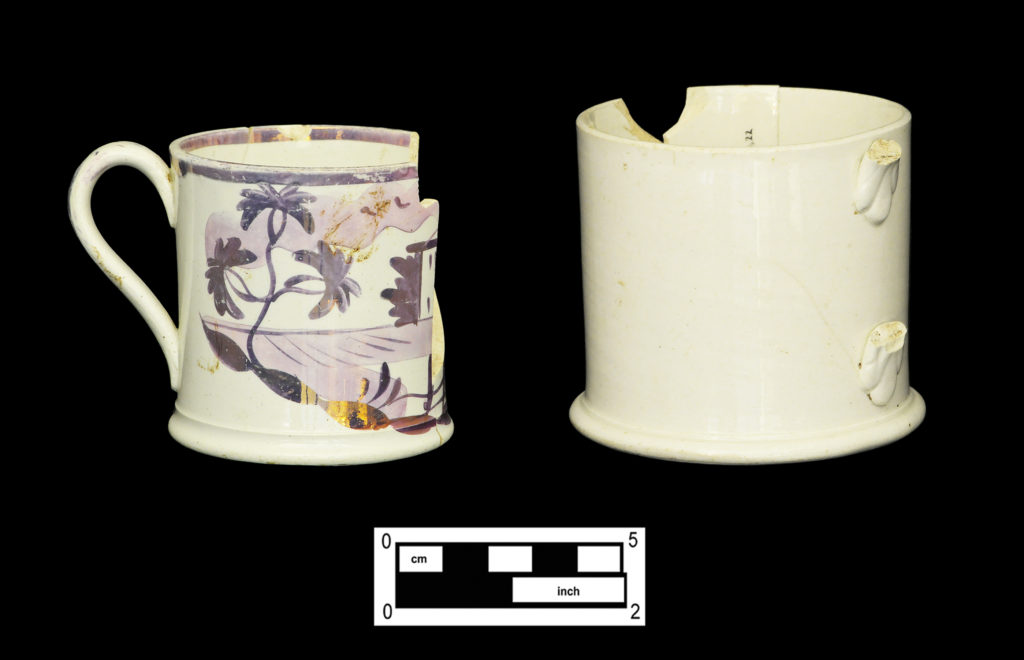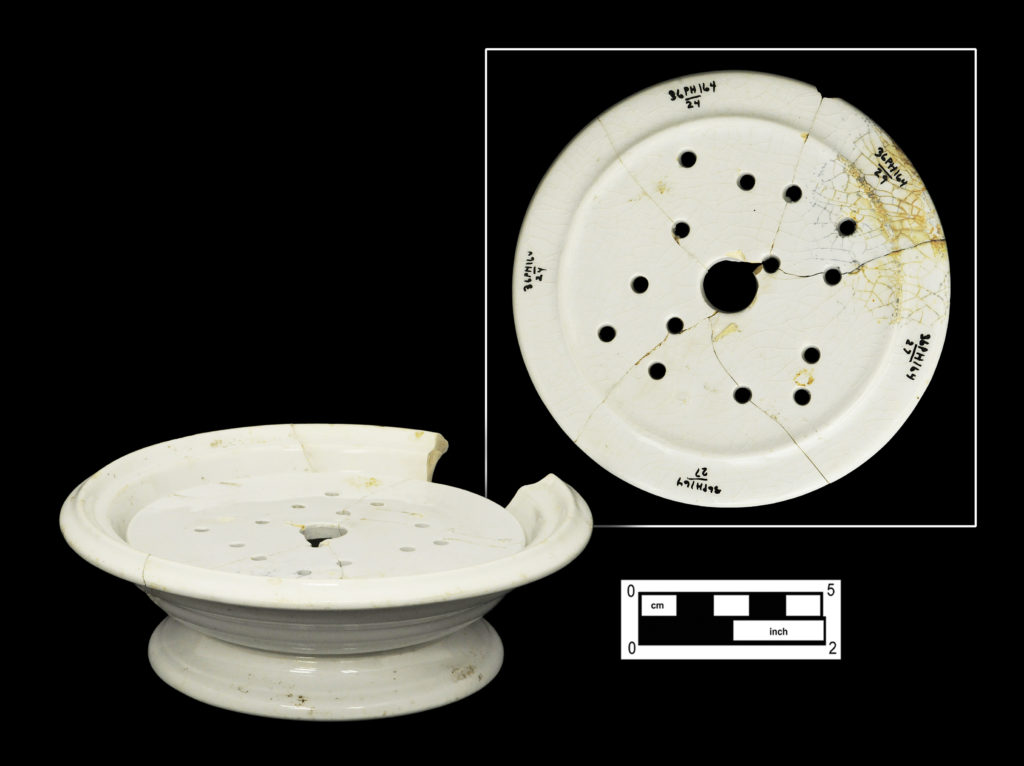Most of the ceramic vessels excavated from this privy feature constitute the table, tea, serving, and food-storage vessels commonly used in many homes during the mid-nineteenth through early twentieth centuries. Although somewhat plain and lacking in color, the volume of material recovered and the completeness of the vessel forms calls for further examination. Also of interest are a number of vessels with manufacturer’s marks that provide additional information, such as country of origin, and aid in determining the dates of production.
Pieces from several different sets are evident, which may be related to the different families that occupied this household. It was common during this period for the tea ware to be a different style and pattern than the dinner service, possibly another factor in the recovery of pieces from different sets. Throughout the nineteenth century, many additional tableware forms were introduced and became fashionable, and matched pieces were designed for specific functions, such as chop or fish plates and dessert sets.
Some earlier ware types and vessel forms were recovered; however, white granite and hotel ware vessels, particularly in plain and round forms, dominate this ceramic assemblage. Though white granite first appeared in Philadelphia in 1839, it did not become the dominant ware type until the 1860s. Eliza Leslie, Philadelphia resident and author of household advice books, described the fashionable ceramics of the period:
For common, every-day use, china ware of entire white seems now to have superseded all others, and very justly; as, when of good quality, it is pure and delicate in its appearance, never looks the worse for wear, (as is the case with much of the gilt china,) and when broken is easily matched. 1
These plain, round forms were characteristic of the styles popular during the last quarter of the nineteenth century, between about 1870 and 1890. 2
Teaware

Cups
Among the 19 cups recovered from this shaft; seven are the plain, rounded hotel ware form commonly known as the St. Denis shape, with a distinctive ring-shaped handle. Several earlier styles of white granite cups without handles were also recovered. Among these are vessels that represent some of the molded decorations popular during this period, such as a group of three matching Sydenham shape cups, another cup from a partial set in the Ceres pattern, and a single example of Berlin Swirl.
It is significant to note that no London shape or double curve cups were recovered from this feature, and this absence further supports the dating trend noted in the ware types. London shape cups and bowls were the dominant form between 1825 and 1850, and the double curve shape was popular between 1830 and 1860. 3 The complete absence of these shapes in such a large assemblage again points to a post-1860 deposit. One large breakfast cup resembles the Tulip shape, but this form remained popular from about 1850 through 1925, and does little to refine the date (4A-C-0106). 4

Only a few of the cups from this feature contained any form of printed or decal decoration. A small handled hotel ware cup with an overglaze black decal vine motif appears to be American-made, possibly at one of the potteries in Trenton, New Jersey (4A-C-0105). Another small handled hotel ware cup features a reddish-brown printed chintz-like pattern, consisting of fruit and leaves. This chintz pattern is reminiscent of the designs produced during the Aesthetic Movement (4A-C-0107). A small hotel ware cup with an overglaze floral decal motif matches two saucers with maker’s marks connecting them to the Crescent Pottery in Trenton and dating them from 1899–1902 (4A-C-0075). 5 Apart from their handles, the Crescent Pottery cup and the brown-printed cup feature nearly identical shapes and sizes, and while slightly smaller, the black decal-decorated cup, like the other two, bears a form characterized by roughly equal height and diameter.
Mustache Cup

One of the more unique ceramic vessels recovered from this privy resembles a typical porcelain teacup in form and style of decoration (4A-C-0029). A narrow strip of porcelain added to the interior of the rim reveals that this is a mustache cup—the addition of this protective ledge enabled Victorian men to keep their sculpted hairs neat and dry. Facial hair was considered a symbol of manhood in Victorian culture, and in keeping with the fashion of the times, men often curled, dyed, and waxed their mustaches. The use of various products in grooming facial hair caused embarrassment at tea time, when contact with the hot beverage would melt the wax and dye, and men would be left with a drooping, dripping mustache.
The base of this mustache cup has a manufacturer’s mark for Carl Tielsch & Company of Altwasser, Germany (present-day Stary Zdrój, Poland). This porcelain manufacturer used several different maker’s marks to identify their ceramics over the company’s lengthy history. Carl Tielsch and Company used the green printed mark on this cup of an eagle with outstretched wings over the letters “C.T.” from 1875 to about 1900. 6 In addition, this piece was stamped a second time in blue over the green printed mark “MADE IN GERMANY.” Beginning in 1887, “English law required imported wares to be marked with country of origin.” 7 This second mark provides further assistance in dating the manufacture of this mustache cup to between 1887 and 1900. Though Tielsch & Company produced a wide variety of products, they were one of the many potteries who made mustache cups.
Saucers
A total of 22 saucers were recovered, eight of which are white granite/hotel ware saucers in plain, rounded forms. Six of these saucers display maker’s marks, including Burgess & Goddard of Longton, England (1842–1890); Moore Brothers, also located in Longton (1872–1891); Willets Manufacturing Company in Trenton (1879–1890 and 1879–1909); and Bridgwood & Son, another Longton pottery firm (1885–1890). 8 An additional five white granite saucers feature molded patterns, including two matching Sydenham shape saucers bearing impressed 1854 registry marks, a Ceres shape saucer with a printed mark from W. & E. Corn of Burslem, Longport, England (1864–1891), an unmarked saucer with a simple paneled motif, and an unmarked Olympic shape saucer (Birks 2013). Elsmore & Forster pottery of Tunstall, England, first registered the Olympic shape pattern in 1864. 9
The eight decorated saucers consist of four hotel ware saucers and four porcelain saucers. All of the decorated saucers bear some form of gilt decoration and four feature overglaze decal decoration, including a matching pair from the Crescent Pottery in Trenton (1899–1902) (4A-C-0017; 4A-C-0018). 10 A Keller & Guérin (1880–1914) saucer from Luneville, France, bears a flow blue printed motif, and a small porcelain saucer features a faded overglaze enameled design (4A-C-0007; Cat # 4.24.100). 11 The remaining porcelain saucer has a simple gilt band. These decorated saucers represent some of the latest ceramic vessels from the feature and are likely the immediate successors to the plain white wares described above. Appropriately, the maker’s marks from the plain and molded white vessels produce a mean date range of 1865–1893, while the decorated saucers yield a mean date range of 1895–1914.
Demitasse
Other unique forms include two small saucers, each measuring less than 4 inches in diameter, suggesting they represent demitasse vessels. The word “demitasse” describes “a small cup for serving strong black coffee after dinner” and originated in France between 1835 and 1845. 12 One of the demitasse saucers has a floral motif hand painted in overglaze enamels of purple, orange, and yellow (4A-C-0020). The molded scalloped rim exhibits the faded remains of an elaborate gilt band, also painted by hand. The other example is a shell or leaf-shaped dish with a molded shell edge extending over much of the interior body and an uneven scalloped gilt rim (4A-C-0110). This small vessel stands out due to the bright green enameling around the rim, which has an airbrushed quality that gradually fades as it approaches the undecorated center. While this dish is similar in diameter to the other demitasse, it is lacking the recessed well at the center, suggesting that it might have had some other function.
Creamers/Sugar
While there was no evidence of a tea or coffee pot among the ceramics from this feature, the excavations yielded portions of two creamers and a sugar. One of the creamers was white granite with an embossed decoration known as Ceres. This creamer appears to match a recovered cup and saucer in the same pattern (4A-C-0096). The base of the creamer is marked “Elsmore & Forster” and “Ceres Shape Tunstall” around a registry mark dated November 2, 1859. 13 The other cream pitcher of soft paste porcelain features a distinctive blue sprigged grape motif with purple luster highlights—a design collectors refer to as “Chelsea grape.” 14 This paneled creamer with a flared, pedestalled foot matches two plates described below (4A-C-0104). The sugar dish is white granite molded in the Sydenham shape and likely part of a matched tea set, as several cups and saucers in this pattern were recovered (4A-C-0098). This vessel has an impressed mark on the base lettered “T. & R. Boote” and “Sydenham Shape” surrounding a registry mark dated 1854. 15
Dining

Plates
Only 10 plates were identified, a small number in comparison with the large quantity of cups and saucers. The single blue shell-edged pearlware dinner plate stands out temporally from the rest of the ceramic assemblage, as its 1800–1840 date range is much earlier than any other artifact date. Two plates of soft paste porcelain, with a sprig-molded grape motif formed of blue clay and highlighted with purple luster, match the Chelsea grape cream pitcher described above (4A-C-0013, 4A-C-0103). According to Kovel’s Antiques and Collectibles Price Guide 2015, “Chelsea Grape pattern was made before 1840.” 16 Although these pieces are unmarked, they were probably manufactured in England. This was a popular pattern during the mid-nineteenth century and members of the Cramp household may have used this set.
Apart from the shell-edged pearlware and pair of soft paste porcelain plates, all of the plates are white granite vessels. Among the English maker’s marks present on these plates are those of Jacob Furnival of Cobridge (1845–1870)(4A-C- 0074); Pearson & Hancock, also of Cobridge (dates unknown)(4A-C-0005); and Gelson Brothers, located nearby in Hanley (1867–1876)(4A-C-0102). 17 One of the two white granite soup plates recovered from this shaft bears an identical Gelson Brothers mark, thus the two vessels may have been part of the same set (4A-C-0101). The other soup plate features a paneled marly and bears both a printed John Wedge Wood mark and an impressed 1847 registry mark (4A-C-0023). This firm operated in Burslem, Tunstall, and was at times confused with the famous Wedgwood pottery. 18
Platters/Deep Dish

All three of the recovered oval platters and a small oval serving dish are plain white granite vessels (4A-C-0004, 4A-C-0080, 4A-C-0001, 4A-C-0086). Only one of the platters bears a maker’s mark consisting of a variant of the British Royal Arms, with the name of the pottery—Alfred Meakin, Ltd.—beneath. This pottery, located in Tunstall, was known to use various marks during its extensive history; according to ceramic historian Geoffrey Godden, this mark was first used in 1897 (4A-C-0001). 19 This platter features a scalloped rim embossed with a beaded band design and scrolls.
Patterns of Wear
The four serving vessels show no evidence of the fine scratch marks that might be expected from stirring or cutting food; instead, all of the wear is on the exterior base. The three platters have light to moderate wear marks confined to the narrow ends of each vessel, which may suggest limited use, or perhaps use on a table covered with a cloth. The small serving dish, which may have been used to convey vegetables and other side dishes from kitchen to table, has no obvious use marks on the interior and light to moderate wear on the base.
Pitchers

Ceramic pitchers were used on the table for milk, water, cider, and various other beverages. Vessels with pouring lips were also necessary during food preparation in the kitchen. All four of the ceramic pitchers from this shaft feature are relatively small in size (measuring between 5.5 and 6 inches in height). A pair of whiteware pitchers exhibits the same light blue printed romantic scene of people viewing a European landscape along a river. The hexagonal form of these pitchers suggests they might have been used on the table with the paneled white granite plates described above. The base of each pitcher has the printed mark that registered the pattern to James Edwards, on Nov. 5, 1844 (4A-C-0114, 4A-C-0112). Edwards operated his pottery at Dale Hall, Burslem, from 1842 through 1882. 20 The bases of the two pitchers are also noteworthy for the distinctive difference in the pattern of wear exhibited. One shows light wear distinguished by a few brown stains around the outer edge of the foot ring. The other pitcher shows a pattern of dark staining on the foot ring in places where the glaze was worn away through heavy use.
Another molded pitcher features an irregular scalloped rim with impressed shell-like edging and a scroll handle (4A-C-0024). The refined white body is covered with blue that appears sponged in some places and dripped in others—among collectors, this type of decoration is referred to as blue Rockingham. 21 Although references are somewhat limited, this type of ware “seems to be an almost purely American product.” 22 This vessel is unmarked; however, a glaze flaw on the body suggests that it was locally made. Some marked examples of blue Rockingham exist in private collections, and among the known manufacturers of this ware were J. E. Jeffords’ at the Philadelphia City Pottery and several potteries in nearby Trenton. 23
The white granite pitcher is undecorated, except for a wide scallop at the rim (4A-C-0014).
This plain pitcher may have been used in the kitchen or perhaps represents part of a sanitary set. The base is marked with a black printed British Royal Arms and lettered “IRONSTONE CHINA / N. P. Co.”; to date, this mark has not been identified with a specific manufacturer.
Additional Forms
Several other vessels were recovered in smaller numbers and provide examples of some of the specialized forms in use during this time period.
Mugs

The two mugs from this shaft feature vary in both size and decoration. The pearlware mug was painted by hand with pink/purple luster, which maintains its metallic shimmer despite some overall fading due to weathering in the ground (4A-C-0111). This small mug measures 2.6 inches in height, with a rim of only 2.5 inches in diameter—a size that would make it manageable for a young child. Although a portion of the decoration is missing, enough survives to identify a commonly used stylized landscape scene referred to by collectors as “cottage” motif. 24 Sources vary regarding the date range for this decoration. Gibson shows several vessels decorated in a similar motif and provides a date of circa 1820. 25 A Collector’s History of English Pottery illustrates a jug with almost identical motif and gives circa 1850 as a date. 26 Both of these dates suggest that the piece belonged to a member of the Cramp family and may have been a long-cherished mug.
The other mug is plain pearlware or whiteware with no evidence of any decoration, except for molded foliate handle attachments (4A-C-0026). This mug has a height and diameter measuring 3 inches and may have been used on the table for milk, cider, or water. Plain mugs like this one were useful in the kitchen or might be part of a sanitary set. The foot ring of both mugs exhibit light to moderate fine scratches consistent with wear from use.
Slop Bowl
One single large sherd represents a paneled white granite bowl with an approximate rim diameter of 6 inches (Cat # 4.24.56). A bowl of this size was often placed on the table during tea as a receptacle for the used tea leaves before refilling the cups.
Covered Butter

A white granite butter dish featuring a perforated insert plate was identified from this shaft feature; however, there was no evidence of the domed lid that once covered it (4A-C-0099). Newspaper advertisements reveal that butter dishes like this one were particularly useful during the summer months. On June 7, 1844, an advertisement in the Richmond Whig offered “Covered butter plates and drainers –White China and White Granite covered butter plates, an excellent article for the present season of the year…” 27 A notice printed in the Poughkeepsie Journal on August 18, 1855, describes the advantage of this style of dish:
A new butter dish has been invented, by which, in summer, the annoyances heretofore attending other kinds of “coolers”—as the slipping off the ice—the dissolving of the salt with which the butter is flavored by the water from the melting ice—are entirely done away with. The improvement consists in a reservoir beneath the butter in which the ice is placed… 28
The butter would be placed on the perforated insert positioned directly above the ice. The recovered example is printed on the base with the mark of Pankhurst & Company, a pottery in operation in Hanley, England, from about 1852–1882. 29 The foot ring shows moderate to heavy use, and a few areas where the glaze is completely worn off.
Individual Butters
Two small plates appear to represent butter dishes for individual use. Individual butters—sometimes called “butter chips” or “pats”—became increasingly popular during the final quarter of the nineteenth into the early twentieth centuries. 30 One of the recovered examples is a portion of a square plain white granite dish with a beaded band molded into the rim. The fragment bears a partial printed mark for Powell & Bishop, also of Hanley and partners in the pottery from 1876–1878 (4A-C-0108). 31 The other individual butter is unmarked and decorated with overglaze decal flowers and a faded gilt rim (4A-C-0031).
Fruit Saucer
Initially, this small dish was identified as one of the many tea saucers from this shaft (4A-C-0002). Measuring only 4.75 inches in diameter, the dish is somewhat smaller than the majority of the saucers. On closer inspection, we noticed this dish lacked a specific detail that made us reexamine it. This vessel does not possess the molded circular well in the center for a cup to rest, an indication that this was a dessert dish called a fruit saucer. The overglaze decal decoration dates this dish to 1890 or later, when fruit saucers were often part of larger dining ware sets offered in catalogs. 32
Victorian Dining Wares
The majority of the ceramics from this shaft feature consist of tea and tablewares, with cups and saucers making up half of the assemblage. The primary date range of the ceramics spans the period dominated by white granite, from the 1860s through the end of the nineteenth century. American-made decal-decorated wares from the first decade of the twentieth century are represented in smaller amounts.
The latest ware and decoration types in the assemblage focus primarily on the cups and saucers, with the majority of the serving vessels and plates being both plain and molded white granite forms. The large number of teawares and their wide variety of decorative styles express the Victorian preoccupation with entertaining and parlor use. The dominance of these teawares likely results from these vessels being used more frequently and by more people than the tablewares. Their exposure to visitors and guests meant more chips and breakage, resulting in replacements with the latest styles.
At first glance, the ceramic assemblage from this shaft feature appears somewhat plain and of less merit than some of the other artifacts types recovered. With a closer look and some additional research, we found out more about several Victorian vessel forms and discovered pink lusterware and blue Rockingham. The more commonplace saucers and plates added a variety of different maker’s marks, representing not only English and American manufacturers, but French and German, as well.
References
- Eliza Leslie, Miss Leslie’s Lady’s House-Book; A Manual of Domestic Economy (Philadelphia, PA: Henry Carey Baird Industrial Publisher Reprint, 2012), 290, accessed June 2017, www.forgottenbooks.org. ↩
- Patricia Samford and George L. Miller, “Post-Colonial Ceramics: White Granite (aka White Ironstone),” Diagnostic Artifacts in Maryland, accessed June 19, 2013, http://www.jefpat.org/diagnostic/Post-Colonial%20Ceramics/White%20Granite/index-whitegranite.html. ↩
- George L. Miller, “Common Staffordshire Cup and Bowl Shapes,” Diagnostic Artifacts in Maryland, 11, 12, accessed June 19, 2013, http://www.jefpat.org/diagnostic/Post-Colonial%20Ceramics/Cup%20Shapes/Essay%20on%20Cup%20&%20Bowl%20Shapes.pdf. ↩
- Ibid., 13. ↩
- Edwin Atlee Barber, Marks of American Potters (Philadelphia, PA: Patterson & White Company, 1904), 63. ↩
- Christopher S. Marshall, “Silesia: Altwasser (Stary Zdrój),” Porcelain Marks & More, accessed March 1, 2013, http://www.porcelainmarksandmore.com/silesia/altwasser_1/00.php. ↩
- Ralph and Terry Kovel, Kovel’s New Dictionary of Marks (New York, NY: Crown Publishers, Inc., 1986), 231. ↩
- Steve Birks, “Alphabetical Index,” A–Z of Stoke-on-Trent Potters, accessed March 1, 2013, http://www.thepotteries.org/allpotters/index_alpha.htm; Lois Lehner, Lehner’s Encyclopedia of U.S. Marks on Pottery, Porcelain & Clay (Paducah, KY: Collector Books, 1988), 522; Geoffrey A. Godden, Encyclopaedia of British Pottery and Porcelain Marks (London: Barrie & Jenkins, 1993), 102. ↩
- Jean Wetherbee, White Ironstone: A Collector’s Guide (Dubuque, Iowa: Antique Trader Books, 1996), 134. ↩
- Lehner, Encyclopedia of U.S. Marks, 114. ↩
- Jeffrey B. Snyder, Historic Flow Blue, with Price Guide (Atglen, PA: Schiffer Publishing, Ltd., 1994), 72. ↩
- Dictionary.com, s.v. “demitasse,” accessed July 2017, http://www.dictionary.com/browse/demitasse. ↩
- Ernie and Bev Dieringer, White Ironstone China (Atglen, PA: Schiffer Publishing Co., 2001), 126. ↩
- Terry and Kim Kovel, Kovel’s Antiques and Collectibles Price Guide 2015 (New York, NY: Black Dog & Leventhal Publisher, 2014), 114, accessed July 12, 2017, https://books.google.com/books?id=IA9oBAAAQBAJ&pg=PA114&lpg=PA114&dq=chelsea+grape+luster&source=bl&ots=kjiyJNZHux&sig=DSouFW6w_45-KwMLejV8dbRMKMw&hl=en&sa=X&ved=0ahUKEwjM3Mzn9oPVAhUlG5oKHZshAwYQ6AEIZjAP#v=onepage&q=chelsea%20grape%20luster&f=false. ↩
- Dieringer, White Ironstone China, 53. ↩
- Kovel, Antiques and Collectibles Price Guide 2015, 114. ↩
- Birks, “Alphabetical Index.” ↩
- Ibid. ↩
- Godden, Encyclopaedia of British Pottery and Porcelain Marks, 425. ↩
- Jeffrey Snyder, Romantic Staffordshire Ceramics (Atglen, PA: Schiffer Publishing Co., 1997), 56. ↩
- Earl F. and Ada F. Robacker, Spatterware and Sponge (Cranbury, NJ: A. S. Barnes and Co., Inc., 1978), 73. ↩
- Ibid., 65. ↩
- Ibid., 68, 69. ↩
- Michael Gibson, 19th Century Lustreware (Woodbridge, Suffolk, England: Antique Collectors’ Club, 1999), 14, 45. ↩
- Ibid., 15, 38, 45. ↩
- Griselda Lewis, A Collector’s History of English Pottery (Woodbridge, Suffolk, England: Antique Collectors’ Club, 1999), 156. ↩
- “Covered Butter Plates and Drainers,” advertisement, Richmond Whig (Richmond, VA), June 7, 1844, p. 2, Genealogy Bank, subscription database accessed February 2017, http://www.genealogybank.com. ↩
- Advertisement, Poughkeepsie Journal (New York, NY), August 18, 1855, p. 2, Newspapers.com, subscription database accessed February 2017, http://www.newspapers.com. ↩
- Godden, Encyclopaedia of British Pottery and Porcelain Marks, 481. ↩
- Montgomery Ward & Co., Montgomery Ward & Co. Catalogue and Buyers’ Guide Spring & Summer 1895 (New York, NY: Dover Publications, Inc., 1969), 531; Sears, Roebuck, Sears, Roebuck Catalogue, 1897 Edition (New York, NY: Republished by Skyhorse Publishing 2007), 617. ↩
- Godden, Encyclopaedia of British Pottery and Porcelain Marks, 509. ↩
- Montgomery Ward & Co. Catalogue, 530; Sears, Roebuck Catalogue, 1897 Edition, 617; Sears, Roebuck, Sears, Roebuck Catalogue, 1908 Edition (Northbrook, IL: Republished by DBI Books, Inc., 1971), 350. ↩









